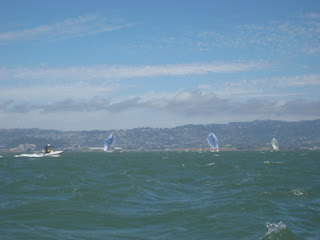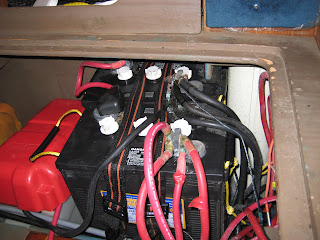The most obvious thing we noticed when we did our first walk through on Circe was the low grade 'cessy' odour from the head. It wasn't oppressive but it was indicative of a bigger problem in the making and something we didn't want to live with. The head was an old Raritan manual unit with raw water flush into the original holding tank. The system had been re-plumbed at some point with with a low end sanitation hose but the layout was weird, the manual discharge pump for the holding tank was in-line between the tank and deck plate rather than teed off the bottom tank fitting which is more usual. Also, there was a bad kink in the hose between the holding tank and the discharge pump, a perfect point for clogs and almost impossible to clear without disconnection...YUK!! Basically the whole arrangement needed to be upgraded. We did a lot of research on system layout and types of head and got a lot of useful information on system design from Peggie Hall's site.
http://www.boatbuilding.com/article.php/MarineSanitationFactvsFolklore#marine
Choosing the actual toilet 'device' was a bit more difficult as there are so many products promising perfection! After polling FOGgers and others, reading a lot of reviews and comparing features we decided to go with a Tecma Easy Fit, an electric unit with integral macerator. A new holding tank, 'Odor Safe' hose and a system redesign to allow us the choice of either raw water or fresh water flush completed the package.
http://www.yachtproductsintl.com/category.aspx?categoryid=87
The new holding tank and manual discharge pump is now correctly plumbed with a U fitting to eliminate hose kinks. Note the nice big half inch vent elbow on the corner of the holding tank. We considered putting a second vent on the opposite corner to induce a cross-tank flow of air, and may still do that based on how the system works in practice. Plenty of air going through the holding tank goes a long way to controlling odour.
We went with the 'short' version of the Tecma Easy Fit which is designed to sit on a step. It was a perfect fit. The locker door behind cleared the seat cover (barely!) and so we only needed to put a longer hook on the entrance door stop to get a nice clean installation.
From our pre-installation measurements we thought we would need to trim a bit off the louvre door to the locker behind the head but in the end we had about a quarter inch of clearance. That was a pleasant surprise.
The entrance door stop was also easily fixed with a longer hook that gives about a half inch clearance.
The controls are simple. The optional selector switch on the right can be set to either house (fresh) or raw (salt) water flush to match the flush water Y valve position. Pushing the button on the left delivers a shot of water to wet the bowl. Pushing the button on the right flushes the head and delivers a dose of rinsing water, then repeats a second time. The small holding tank icon in the bottom right corner of the control panel normally glows green. If the holding tank fills and trips the level sensor (last photo below) the icon in the left corner turns red and the head will not flush until the tank is emptied. It can be overridden in an emergency.
Front view of the two Y valves for switching between fresh and raw water flush (top) and between holding tank or overboard discharge (bottom). The discharge Y valve and the through hull valve (not shown) are both 'red sealed' to keep the Coasties and the Harbormaster happy.
Back view of the two Y valves which select fresh or raw water flush (top) and holding tank or overboard discharge (bottom). Also visible is the power feed to the integral macerator.
Diaphragm pump for raw water flush.
The holding tank level sensor is the flat red and black gizmo next to the inlet elbow. If the holding tank fills up to the sensor, it trips an alarm and also prevents the head from being flushed. There are two free pump-out stations at our marina and a weekly visiting pump-out service if we get lazy, so we don't have any excuse for letting the tank get that full!
Its still early days but, so far, everything seems to be working as advertised. As every matelot knows, marine heads of all stripes are notorious for problems, both operator and system related, so we are keeping our fingers crossed and hoping we don't have to keep updating this post based on future problems!
Its still early days but, so far, everything seems to be working as advertised. As every matelot knows, marine heads of all stripes are notorious for problems, both operator and system related, so we are keeping our fingers crossed and hoping we don't have to keep updating this post based on future problems!

































.JPG)

.JPG)



